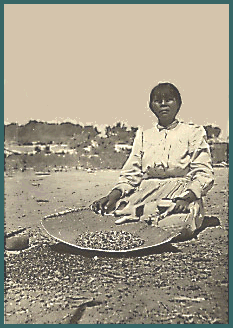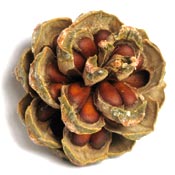History of Pine Nuts & The People of the Great Basin

"Understand that the pine nut was to the people of the Great Basin what the buffalo was to the plains people." The nut is protein packed with all 20 amino acid and very high in concentration in 8 of the 9 amino acids necessary for growth.
The nut was a staple in the diet of all the peoples of this region. It was a life-link food with gatherings celebrations, creation stories and teachings all accompanying the yearly harvest. For in excess of 10,000 years - that is neither a mistake or an exaggeration- native american people harvested the pinon. The Washo, the Shoshone, Paiutes, Hopi and their ancestors ate pinon nuts as a major, storable , multi -faceted food.
Long before Euro-Americans entered the Great Basin, substantial numbers of people lived within the present boundaries of the Great Basin. Archaeological reconstruction suggest human habitation stretching back some 12,000 years. The earliest known inhabitants were members of what has been termed the Desert Archaic Culture-nomadic hunter-gatherers with developed basketry, flaked-stem stone tools, and implements of wood and bone. They inhabited the region between 10,000 BC and AD 400 These peoples moved in extended family units, hunting small game and gathering the periodically abundance.
The Great Basin provided small game for the Northwestern bands, but of even greater importance were the grass seeds and plant roots which grew in abundance in the valleys and along the hillsides of northern Utah. There are probably one hundred different species of grass, in the Basin, that provide harvestable seeds. One could walk through the grass with a tray and a beating stick, emptying the tray into a burden basket, occasionally. Seeds could be stored without much treatment; eventually, they could be ground into flours. By far the most important seed to the Great Basin people was the pine nut, taken from the single-needle pinyon pine (pinus monophyllia) or the double-needle pinyon (pinus edulis); though this culture developed later in the archaic period.
The pine nut is large and an excellent food source. It is, however, relatively difficult to harvest and requires a substantial group effort to do so. The pine nut harvest began in the late summer and lasted into the fall. It was essentially the last big food-gathering opportunity of the year Before retirement into winter lowland quarters. It occurred at intermediate elevations in arid upland hills where junipers and pinions tend to grow. It was a significant social occasion, and most Great Basin people held these regions to be sacred ground.
Over the last two thousand years, the pine nut sustained these peoples. The pine nuts required substantial processing and, then, they could be stored for later use. and utilization of pine nuts required technological innovations. While nuts can easily be picked from the ground fallen cones of the pinyon pine (pinus monophyllia), they are rarely good for human consumption by that time and the crop has been substantially reduced by insects and small mammals.
The pine nut came to be a useful staple food because only after the people learned how to harvest the nut prior to the final ripening stage of the cone. The technology for achieving a pine-nut harvest was messy and complex, and it was practiced communally. In fact, pine-nut harvest defined the great social time of the year, being the greatest gathering of the people in the concentrated areas of sacred lowland pinyon forest. People went to the forests in the early fall before the cones had fully ripened and dropped. They began with "first fruit" celebrations that confirmed the sacred significance of the food and established their respect for the forests.
When harvest began, the men pulled cones from the trees using tools made from large willow branches equipped with a sturdy V-shaped hook at the end. Women and children piled the cones in burden baskets (usually large conical wicker baskets carried on one's back with a cordage band across the forehead). At this point, the cones were just at the point of opening and were usually full of pine pitch.
In camps surrounding the forest harvesting grounds, the pine cones were processed. This began by roasting the pine cones around hot coals, turning them often, to cause them to open up. Then, the cones could be beaten lightly to cause the nuts to fall out. When a supply of nuts was available, these required further processing since the nuts were covered by a soft brown shell. Cracking this shell would be difficult and would injure the fruit inside The nuts were processed by placing them on a basketry tray with hot coals from the fire. Once introduced together, the whole mass was kept in constant motion, throwing them up and swirling the tray, until the shells were roasted to a hard, crisp dark brown. The coals were removed at this point and the nuts were poured onto a grinding stone where they were lightly pounded with a mano until all of the shells had cracked and falled free of the inner fruit.
Cracked pinenuts are yellow-orange, translucent and soft. They can be eaten at this point and are delicious. Far more pine nuts were harvested than could be eaten raw so they needed to be processed further. At this point, the nuts were returned to a winnowing tray and thrown repeatedly into the air to allow the cracked shells to be carried off by the wind. When the shells were all gone, hot coals were returned to the tray and the roasting process was repeated until the nuts were dry and hard, somewhat darker in color.
At this point, the nuts could be stored in large basketry storage containers for later use. Dried nuts could still be eaten without further processing but the usual procedure was to make a pine-nut flour by grinding them. They were returned to the grinding stone and the mano was used to pound them lightly until they were well fragmented. Grinding was achieved with small amounts quickly so that the fine flour could be pushed off the metate forward into a bowl or onto a tray. A soap-root brush light be used to move the pine-nut flour on the tray. When enough flour was available, it could be warmed in water to make a thick paste; then the paste could be reduced, by dilution, to make whatever consistency was desired. While pine-nut mush may not sound especially appealing, addition of berries, various leafy vegetables, and/or ground meat or fish made it a feast.
Tah-Gum, The Washoe Pine-Nut Harvest video is $19.95 per copy plus $5.00 shipping for one copy and 50 cents shipping for each additional copy. You may order with a credit card by phone (775) 784-6932 or FAX (775) 784-1365 or mail a check made out to "Board of Regents". Mail to Oral History Program, Mail Stop 324, University of Nevada, Reno, Nevada 89557
Also - see our resource pages to learn about the history of pine nut harvesting from Public Lands in the Southwestern United States.
Search our blog for stories about pine nuts and native people.




